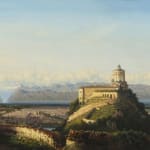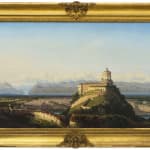-
Artworks


Francesco GAMBA TURIN 1818 -1887
Panorama of Turin from the Villa Barbaroux, 1851Oil on canvas95 x 200 cmSigned and dated lower center: "F. Gamba 1851" - on the back exhibition lebels: "V.E. / N° 81 and N° 11"
SOLD
ITALIAN FOUNDATION
Exhibitions
Promotrice di Belle Arti, Turin, 1852
Una infinita bellezza. Paesaggio in Italia dalla pittura romantica all’arte contemporanea , Reggia di Venaria Reale, Citroniera, Turin, 2021
Literature
P. Giuria, Del paesaggio e de’ paesaggisti piemontesi…1853, pp. 23-27, ibid 211;
E. Bellini, Pittori piemontesi dell’Ottocento e del primo Novecento (delle Promotrici Torinesi) 1998, Turin, Libreria Piemontese Editrice, p. 191Una infinita bellezza. Paesaggio in Italia dalla pittura romantica all’arte contemporanea , Reggia di Venaria Reale, Citroniera
In 1842 Francesco Gamba took part in the very first exhibition to be staged by the Società promotrice delle belle arti in Turin, and indeed in many editions thereafter, showing several new landscapes alongside other young landscape artists such as G. Camino, A. Beccaria, F. Cerruti Bauduc, E. Perotti and C. Piacenza.
In the 1846 edition of the Promotrice he showed about a dozen paintings providing a virtually complete anthology of the study trips he made between 1842 and 1845 to Rome, Naples and Venice, where Italian and foreign artists were wont to meet. Of considerable significance are Gamba’s works purchased in those years by the Nigra family of bankers (The Grand Canal in Venice and Lake Maggiore between Baveno and Stresa) and by Giovanni Mestrallet (A Marshy Spot in the Canavese), testifying to an early interest on the part of Turin’s rising bourgeoisie in the artist’s landscape painting.
Between 1845 and 1855 Gamba went on a considerable number of trips abroad, coming into contact with artists of the School of Fontainebleau and with painters of the School of Düsseldorf, in particular with seascape artists A. Achenbach and H. Mevius.
In 1853, art critic and landscape painter P. Giuria added Gamba to the list of artists of his generation who made up the new “Piedmontese School” of landscape painting that marked its distance from academic art to seek its inspiration directly “in the open air, in touch with living nature” (p. 211) while at the same time shunning an exclusively imitative approach to nature. Within this interpretative pattern, Gamba was given credit for renewing “the seascape genre […] meditated from life”., yet Giuria also pointed to the Panorama of Turin (1852) and to the Panorama of Moncalieri Looking West (1853: Agliè, castle) as being representative of his art.The Panorama of Turin to which Giuria refers may be identified with the painting under discussion here, in which a meticulous topographical view of the city seen from the 18th century Villa Barbaroux is dominated by the silhouette of the church of Santa Maria al Monte dei Cappuccini. This church, built over the foundations of an ancient fortress to a design by Giacomo Soldati subsequently modified by Ascano Vitozzi, marked the symbolic value of the policy of alliances that the House of Savoy forged with the religious orders in the 16th and 17th centuries.
Gamba’s work was very much appreciated also by the royal family, especially by the Queen Mother Maria Theresa of Habsburg and by Oddone of Savoy, as well as by various members of the Piedmontese aristocracy such as Count Cristino d’Entrèves, Ciunt Carlo Arnaboldi Gazzaniga and Marquis Filippo Ala Ponzoni.
The Swelling Sea, Setting Off To Fish is now in the collections of the Galleria Civica d’Arte Moderna e Contemporanea in Turin, while an oil on cardboard entitled Seascape, dated 1865 and now in the Galleria d’Arte Moderna in Genoa, originally formed part of Oddone of Savoy’s collection of landscape paintings.
Join the mailing list
Subscribe to our newsletter to receive all the news about exhibitions, fairs and new acquisitions!



